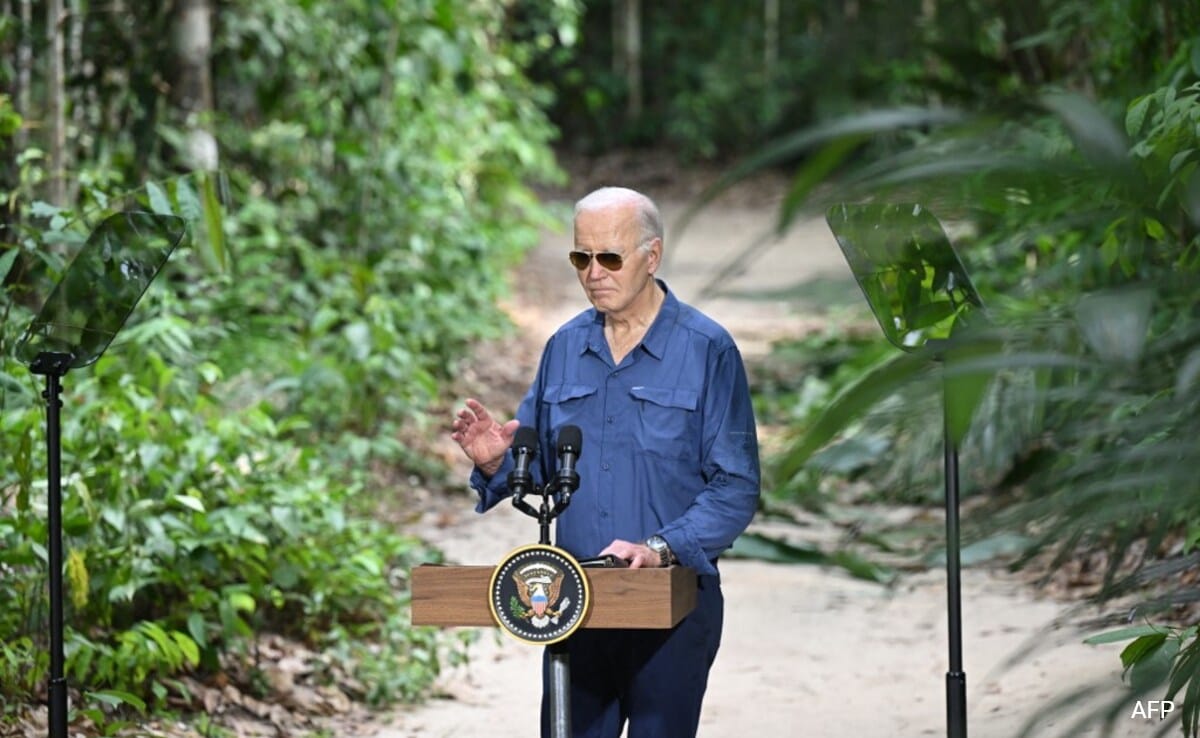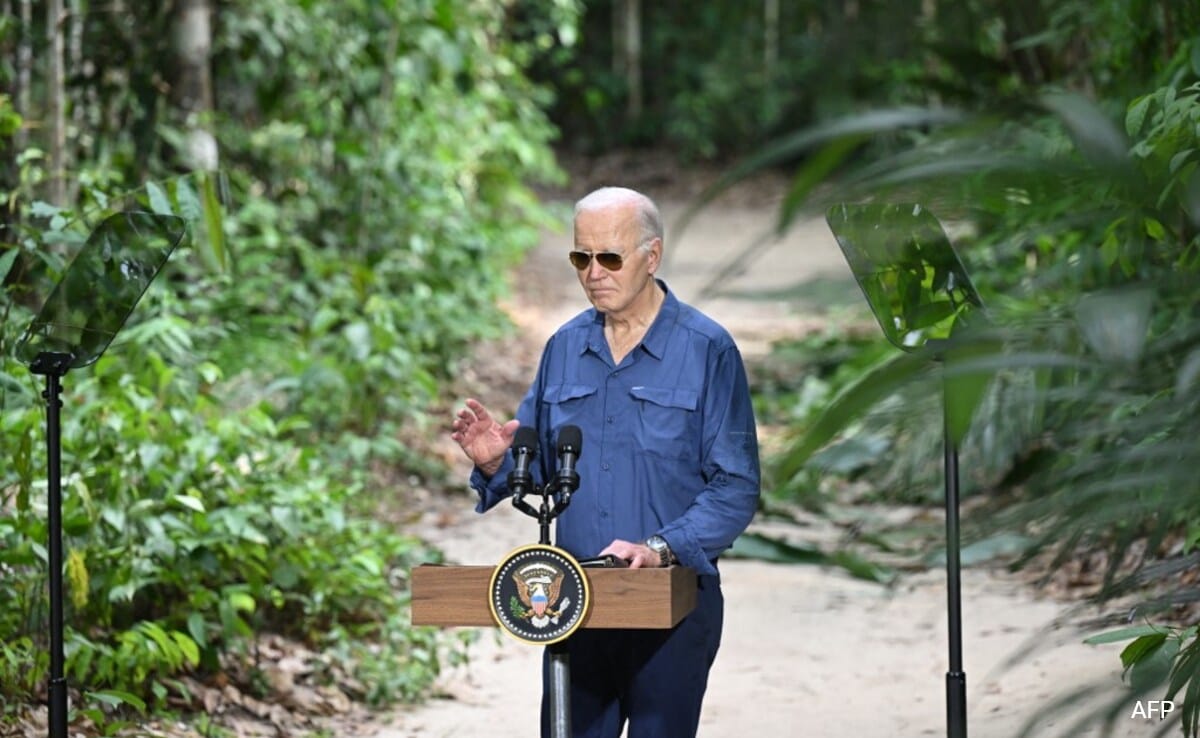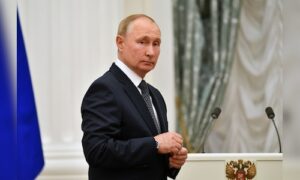

Four years ago, President Joe Biden declared “America’s back” and told his fellow world leaders that Donald Trump had been an aberration.
On a valedictory visit to Peru and Brazil this week, it was Biden who faded from view – and straight into the Amazon rain forest – as Trump’s return to power comes into sharp relief.
That scene in the Brazilian jungle in Manaus offered a bizarre and meme-worthy image from Biden’s six-day trip to South America. After delivering remarks from a podium set up on a dirt path about the need to keep fighting climate change, he took no questions and instead turned and walked off into the trees.
Aides insisted this was all part of the plan – where else was he supposed to go, after all? But the visual of Biden ambling slowly away from the camera and disappearing from view brimmed with melancholy symbolism around the end of this presidency.
His trip to the region for the Asia Pacific Economic Cooperation forum in Lima and the Group of 20 summit in Rio de Janeiro was meant to reassure allies. Instead, it left an impression that Biden’s foreign policy, and not President-elect Trump’s, had been the aberration, and that relations with the US are about to get a whole lot rockier.
World leaders who attended the summits made clear they were bracing for dramatic policy shifts from the White House, especially on Russia’s war in Ukraine. Even leaders who align ideologically with Trump seemed shaken by the scale of the upheaval that may come.
“On potential US disengagement, we have to do all we can to prevent the western front from fraying,” Italian Prime Minister Giorgia Meloni told reporters in Rio de Janeiro. “I think everyone realizes where the truth lies in the Ukrainian conflict and Russia’s responsibility in not wanting to engage in dialog.”
Biden’s approach to the summit had the air of a popular elder statesman saying his last goodbyes. He never took questions from the press, and limited himself at the G-20 meeting to brief public remarks. Cameras caught him backslapping and hugging fellow leaders, many of whom were presumably seeing him for the last time as president.
Evidence that Biden’s team wasn’t up for a fight was everywhere. Brazil declined to invite Ukraine’s leader, Volodymyr Zelenskiy, to the event, and the G-20’s final communique was rammed through by the host, President Luiz Inacio Lula da Silva, despite opposition from other nations over the weakness of its language on Russia’s war in Ukraine and the conflict in the Middle East.
“As you know, this is my last G-20,” Biden had said on Monday, the G-20 summit’s first day. “We’ve made progress together, but I urge you to keep going – and I’m sure you will, regardless of my urging or not.”
The next day, after discussing climate finance, Biden cut himself off. “I have much more to say,” he said, according to a pool report. “I’m not going to.”
His refusal to engage with the news of the day also meant that he never provided a justification or explanation for one of the last foreign-policy decisions of his presidency: allowing Ukraine to fire long-range US-provided ATACMS missiles into Russian territory.
That decision came to light on Sunday. German Chancellor Olaf Scholz made clear a day later that he wouldn’t follow Biden’s example and that Berlin would continue to refuse to supply its Taurus missile system to Ukraine.
By Tuesday, Ukraine had fired ATACMS at an ammunition depot in Russia’s Bryansk border region, though it didn’t officially acknowledge that the US weapon was used. The same day, the Kremlin announced that President Vladimir Putin had signed off on a revised nuclear doctrine that lowered the threshold for Russia to resort to using the weapons.
The use of ATACMS represented “a qualitatively new phase” of the war, Russian Foreign Minister Sergei Lavrov told a news briefing in Rio, addressing reporters in English on the question. “And we will react accordingly.”
Throughout his presidency – and for decades before as a US senator and vice president – Biden had set his aides on edge with off-the-cuff remarks and verbal gaffes. This time, he resisted once again.
“Mr. President, why did you change your mind on Ukraine shooting long-range missiles?” a reporter shouted to Biden during a camera spray on Tuesday as he met Lula.
Biden appeared ready to respond but then decided to keep the silence he has largely maintained in the two weeks since Vice President Kamala Harris lost the US election to Trump. Instead, US adversaries including China President Xi Jinping and allied leaders such as Scholz have filled the vacuum left by Biden.
“I made clear in my talks with Xi that we won’t accept weapons deliveries to Russia and that we will look even closer to dual-use goods for Russia,” Scholz told reporters.
Soon after Lavrov spoke, Biden joined other world leaders for a G-20 group photograph. Cameras showed him coughing into his fist and unwrapping a throat lozenge. Biden, who looked stiff and walked haltingly all week, turns 82 on Wednesday.
The photo opportunity was a redo from the summit’s first day, when Biden along with Canada’s Justin Trudeau and Italy’s Meloni had missed the traditional “family photo.”
That intensified grumbling from White House staffers already irked by what they saw as chaotic organization from the summit hosts. Journalists peppered Brazilian officials about the decision to take the photo without the US president – something unthinkable at any previous G-20 summit, and all the more for a leader making his swan-song appearance.
“Brazil is like this,” Communications Minister Paulo Pimenta explained, according to a pool report. “When it’s time, it’s time.”
Biden has one more foreign trip – to Angola next month – before he leaves office. Even allies seemed to recognize that it’s time to move on.
“The world is changing so fast,” European Commission President Ursula Von Der Leyen said in a post to X that featured a photo of her with Biden and Xi. “So it is good to see familiar faces in these global summits. To greet fellow G20 leaders. And welcome new ones.”



